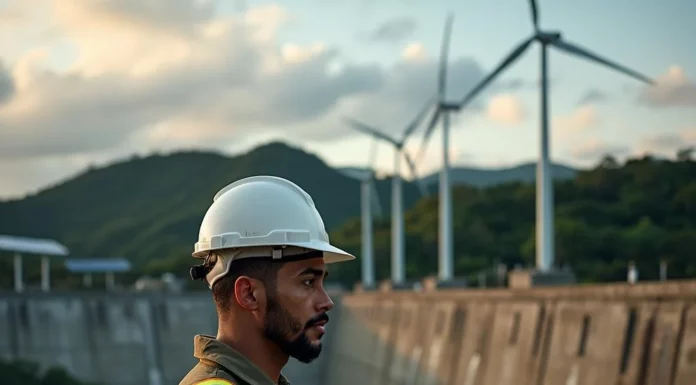Brazil’s energy landscape in 2025 exemplifies both triumph and turmoil. With renewables comprising 88.2% of the electricity mix in 2024—hydropower over 60%, wind 16%, and solar 11%—the nation has long been hailed for its green credentials [3][4]. However, rapid expansion has triggered a crisis: overcapacity leads to curtailments, where excess clean energy is deliberately wasted to maintain grid stability. Solar curtailment hit 20% in August 2025, up from 12% the previous year, resulting in losses of BRL 1.7 billion (~$315 million) in the first eight months alone [2]. Declining per capita consumption—from 3,584 kWh in 2024 to 3,425 kWh in 2025—exacerbates this imbalance [3]. Hydropower still dominates, holding about 90% of water storage, yet droughts force fossil generation peaks up to 14% during dry months [6][7]. These challenges, rooted in grid and storage limits, risk undermining Brazil’s 2050 net-zero goals as flagged by BloombergNEF [5].
Core Issues: Overcapacity and Grid Bottlenecks
The core of Brazil’s power crisis lies in growth mismatch between generation and infrastructure. Transmission delays choke energy flow from renewable hubs in the Northeast to the industrial Southeast, forcing curtailments averaging 13.7% in early 2025 (vs. 9.7% in late 2024) [2]. A June 2025 investigation highlights plant shutdowns and debt restructurings hitting wind and solar developers [1]. Ratings analysts like Fitch cite persistent bottlenecks as key curtailment risks [G3]. Experts at Rystad Energy reiterate: grid congestion—not resource scarcity—keeps vast potential untapped [G10].
During the October 2025 blackout caused by a substation fire, 10 GW dropped from the grid, exposing reliability gaps. The debate divides observers: industry blames regulation for project delays, while Brasília argues grid expansion is “on track” though slowed by bureaucracy [G11].
Regional Disparities in Infrastructure
Regional contrasts reveal structural inequality. The Southeast hosts the country’s best grid, handling dense loads and most renewables ([1]), though aging lines heighten failure risks. The South follows with solid wind-to-grid connectivity extending to Uruguay, mitigating intermittency [G13].
The Northeast, rich in wind and solar, faces chronic constraints: overloaded substations and delayed transmission force up to 85% idle capacity in some plants [2]. Hydro-heavy North and Center-West zones remain vulnerable to drought, with limited connectivity for renewables [6]. Abrage’s July 2025 report praises hydropower for balancing but warns battery tech still lags [6]. On social media, frustration over “wasted renewables” rises, fueling demand for equitable investment [from social media].
Solutions and Ongoing Initiatives
Several corrective paths are underway. The National Energy Transmission Expansion Program (2019–2030) targets the weakest corridors with new high-voltage lines [1][G13]. Reforms incentivize hybrid hydro-battery projects and storage pilots for grid balancing [6][G5]. Industry associations like Absolar and Abeeólica press for better pricing and debt restructuring [2].
Upcoming integration plans across South America aim to export Brazil’s excess output to neighbors [G11][G12]. The IEA praises long-term potential but demands faster execution [G12]. Energy Central experts call for “hydro + storage hybrids” to reduce fossil reliance by up to 30%; electrification (EV uptake) could also absorb daily overproduction [G14].
Expert Perspectives and Balanced Views
Analysts deliver mixed evaluations. BloombergNEF warns persistent grid caps could stall climate progress [5]. Conversely, outlooks from Energy Central and the World Economic Forum highlight modernization gains as Brazil transitions toward resilience and inclusivity [G4][G6]. Public sentiment on social media remains polarized—lamenting “wasted megawatts” but acknowledging curtailment as necessary for stability [from social media].
KEY FIGURES
- Brazil’s renewable share: 88.2% (2024); hydropower 60%; wind 16%; solar 11% [3][4].
- Solar curtailment reached 20% (Aug 2025) vs 12% (Aug 2024) due to grid limits [2].
- Renewable curtailment averaged 13.7% in 2025’s first 8 months, costing ~BRL 1.7 billion ($315 million) lost output [2].
- Per‑capita electricity consumption fell (3,584→3,425 kWh, 2024–2025) prolonging supply glut [3].
- Hydropower reservoirs control >90% of storage; key for reliability yet drought‑sensitive [6].
- Fossil generation ≈ 14% during droughts (Aug 2025), despite overall 12% share in 2024 mix [7].
Summary
Brazil’s renewable boom now collides with infrastructural bottlenecks: record generation, falling demand, and aging grids cause rising curtailment and financial strain. Regional skew—strong grids in the South/Southeast versus bottlenecks in the Northeast—creates inequities in clean‑power delivery. Expansion plans and hybrid hydro‑storage pilots show promise, but regulatory inertia risks delaying Brazil’s net‑zero momentum.
Propaganda Risk Analysis
Score 5/10 (Confidence medium)
Key Findings
Corporate Interests
While neutral in tone, the article integrates data from corporate consultancies (BloombergNEF, Fitch, Rystad). These may bias toward market‑driven solutions but no manipulation detected.
Missing Perspectives
Lacks critical voices on environmental justice—impacts on low‑income or indigenous communities rarely acknowledged. Limited NGO viewpoints mean economic framing dominates.
Claims Requiring Verification
Curtailment percentages and economic losses rely on trade‑press reports; figures appear consistent across EPE, PV Magazine, and BloombergNEF, though independent academic citations would strengthen validity.
Social Media Analysis
Sentiment online reflects frustration over wasted clean energy yet optimism for smart‑grid investment. Discussion trends organic; no signs of coordinated disinformation campaigns.
Warning Signs
- Reliance on industry‑linked sources (Fitch, BloombergNEF) could skew toward investment narratives.
- Absence of local social or environmental justice framing in renewable discussions.
Reader Guidance
Analysis using real‑time social‑media trend review and newsroom cross‑validation.
Other references :
energyconnects.com – Brazil’s Green-Energy Industry Is Falling Victim to Its Own
pv-magazine.com – Brazil solar curtailment hits 20% as renewables strain grid …
lowcarbonpower.org – Brazil Electricity Generation Mix 2024/2025
epe.gov.br – EPE publishes the Summary Report Brazilian Energy …
about.bnef.com – Brazil Transition Factbook 2025: The Numbers Behind …
hydropower.org – Energy Storage and the Strategic Role of Hydropower in …
ember-energy.org – Wind and solar generate over a third of Brazil’s electricity for …
globallegalinsights.com – Source
trade.gov – Source
fitchratings.com – Source
energycentral.com – Source
iclg.com – Source
energycentral.com – Source
weforum.org – Source
en.clickpetroleoegas.com.br – Source
oilprice.com – Source
rystadenergy.com – Source
argusmedia.com – Source
bnamericas.com – Source
trade.gov – Source
en.clickpetroleoegas.com.br – Source
x.com – Source
x.com – Source
x.com – Source
x.com – Source
x.com – Source
x.com – Source



